| letter | no_accents_letter | php_lit_translit | lang | number | name | unicode | text | eng_grk_readable | |||||
|---|---|---|---|---|---|---|---|---|---|---|---|---|---|
☥ |
𓋹 |
|
i-klingon |
0 |
EGYPTIAN HIEROGLYPH | U+78585 |
Ankhi SAnkhi wāw-vav 666/616? Hebrew  א |
||||||
| 𓌀 |
𓌁 |
i-klingon |
0 |
EGYPTIAN HIEROGLYPH S040 |
U+78592 |
Wꜣst-sceptre wɑsɛt waset greek Wꜣstigma stigma ST ϛ | |||||||
𓍿 |
𓍿 |
𓍿 |
i-klingon |
0 |
EGYPTIAN HIEROGLYPH V013 | U+78719 | Representing a tethering rope. It is conventionally colored green. The phonetic value of ṯ is of uncertain derivation. |
|
|||||
𓎗 |
𓇑 |
𐤑 |
i-klingon |
0 |
EGYPTIAN HIEROGLYPH V024 | U+78743 | 𐤑 The hieroglyph for “rush” 𓇑 became 𐤑 named ṣādē meaning “papyrus plant” or “fish hook” to represent the TS sound. In Hebrew it’s צ named “tsadi.” ṣādē pronunciation is not distinguishable from س [s] Ṣādē, Tsade, Ṣaddi, Ṣad, Tzadi, Sadhe, Tzaddik Its shape was similar to modern M, or to a modern Greek Sigma (Σ) turned sideways. Unlike Sigma, whose position in the alphabet is between Rho and Tau, San appeared between Pi and Qoppa in alphabetic order. |
st |
|||||
𓃾 |
𐤀 |
a |
tr |
1 |
EGYPTIAN HIEROGLYPH F001 | U+78078 | 𐤀 The Egyptian hieroglyph for “ox head” 𓃾 𐤟 named kꜣ (or “ka”) became 𐤀 named ’ālep to represent the glottal stop. In Hebrew it’s א named “alef.” Rotated again later, it’s the Greek or Latin A. |
A |
|||||
𓉐 |
𐤁 |
b |
pt |
2 |
EGYPTIAN HIEROGLYPH O001 | U+78416 | 𐤁 The Egyptian hieroglyph for “house” 𓉐 named bayt rotated 90 degrees and one end bent in became 𐤁 ⸱ named bēt to represent the B sound. In Hebrew it’s בּ named “bet.” Rotated 180, it’s the Latin lower-case b. |
B |
|||||
𓌙 |
𐤂 |
g |
sq |
3 |
EGYPTIAN HIEROGLYPH T014 | U+78617 | 𐤂 The hieroglyph depicting a throwing stick and meaning “foreigner” 𓌙 named gꜣ (or “ga”) in Proto-Sinaitic became 𐤂 named gīml to represent the hard G sound. In Phoenician, this was named gimel meaning “camel.” In Hebrew it’s ג named “gimel.” Turned around, it’s the Greek Γ (gamma). |
G |
|||||
𓉿 |
𐤃 |
d |
pl |
4 |
EGYPTIAN HIEROGLYPH O031 | U+78463 | 𐤃 The hieroglyph for “sky” 𓇯 named ḥeret became 𐤃 named dālet meaning “door” to represent the D sound. In Hebrew it’s ד named “dalet.” In Greek, Δ; in Latin, D. |
D |
|||||
𓀠 |
𐤄 |
e |
pl |
5 |
EGYPTIAN HIEROGLYPH A028 | U+77856 | 𐤄 The hieroglyph for “joy” 𓀠 named qꜣ (or “qa”) became 𐤄 named h’ē meaning “window” to represent the H sound (the voiceless glottal fricative, or aspirate). In Hebrew it’s ה named “he.” This sign was used in Greek for Ε. |
E |
|||||
𓌉 |
𓌉 |
f |
sw |
6 |
EGYPTIAN HIEROGLYPH T003 | U+78601 | 𐤅 The hieroglyph depicting a coil of rope and meaning the number “hundred” 𓍢 named šet became 𐤅 named wāw meaning “hook/mace/wand” to represent the W sound. In Hebrew it’s ו named “vav.” In Greek, Y; in Latin, F, U, V, Y, or W. |
F |
|||||
𓎛 |
𓎛 |
c |
pl |
7 |
EGYPTIAN HIEROGLYPH V028 | U+78747 | 𐤆 The hieroglyph that represents duality 𓏭 used as the word ending -j became 𐤆 named zajin meaning “weapon” to represent the Z sound. In Hebrew it’s ז named “zayin.” In Greek and Latin, Z. |
C |
|||||
𓉗 |
𐤇 |
h |
pl |
8 |
EGYPTIAN HIEROGLYPH O006 | U+78423 | 𐤇 The hieroglyph for enclosure 𓉗 (ḥwt) or irrigated land 𓈈 (spꜣt) became 𐤇 named hēt meaning “courtyard” or “wall” to represent the H-bar sound (the voiceless pharyngeal fricative). In Hebrew it’s ח named “het” pronounced as the ch in challah. This sign was used in Greek for H. |
H |
|||||
𓄤 |
𓄤 |
th |
pl |
9 |
EGYPTIAN HIEROGLYPH F035 | U+78116 | The symbol nfr (𓄤), meaning beautiful, was also used to indicate the base level in drawings of tombs and pyramids and distances were measured relative to the base line as being above or below this line. 𐤈 The hieroglyph for a heart and trachea 𓄤 meaning “perfect” or “beautiful” and named nefer possibly became 𐤈 named ṭēt meaning “wheel” to represent the T sound. In Hebrew it’s ט named “tet.” In Greek, it’s the theta: Θ. |
TH |
|||||
𓂝 |
𐤉 |
i |
pl |
10 |
EGYPTIAN HIEROGLYPH D036 | U+77981 | 𐤉 The hieroglyph for “arm/hand” 𓂝 became 𐤉 named jōd meaning “arm” or “hand” to represent the Y sound, as in “you.” In Hebrew it’s י named “yod.” In Greek or Latin, it’s Ι or J. |
I |
|||||
𓂧 |
𐤊 |
k |
i-klingon |
20 |
EGYPTIAN HIEROGLYPH D046 | U+77991 | 𐤊 The hieroglyph for “hand” 𓂧 named ḏeret became 𐤊 named kāp meaning “palm” to represent the K sound. In Hebrew it’s כ named “kaf.” In Greek and Latin, it’s K. |
K |
|||||
𓋿 |
𐤋 |
l |
pt |
30 |
EGYPTIAN HIEROGLYPH S039 | U+78591 | 𐤋 The hieroglyph for “flail” 𓌅 named nekhakha became 𐤋 named lāmed meaning “goad” to represent the L sound. In Hebrew it’s ל named “lamed.” In Greek, Λ (lambda); in Latin, L. |
L |
|||||
𓈖 |
𐤌 |
m |
i-klingon |
40 |
EGYPTIAN HIEROGLYPH N035 | U+78358 | 𐤌 The hieroglyph for “waves” 𓈖 named nwyt became 𐤌 named mēm meaning “water” to represent the M sound. In Hebrew it’s מ named “mem.” In Greek and Latin, it’s our M. |
M |
|||||
𓆓 |
𐤍 |
n |
so |
50 |
EGYPTIAN HIEROGLYPH I010 | U+78227 | 𐤍 The hieroglyph for “cobra” 𓆓 named ḏet became 𐤍 named nūn meaning “serpent” to represent the N sound. In Hebrew it’s נ named “nun.” In Greek and Latin, it’s our N. |
N |
|||||
𓊽 |
𐤎 |
Ξ |
tl |
60 |
EGYPTIAN HIEROGLYPH R011 | U+78525 | 𐤎 The hieroglyph depicting “reed column” and meaning “stability” 𓊽 named ḏed became 𐤎 named śāmek meaning “pillar” to represent the S sound. In Hebrew it’s ס named “samekh.” In Greek, it’s Ξ (xi). |
Ξ |
|||||
𓁹 |
𐤏 |
o |
i-klingon |
70 |
EGYPTIAN HIEROGLYPH D004 | U+77945 | 𐤏 The hieroglyph for “eye” 𓁹 named jarota became 𐤏 named ‘ajin meaning “eye” to represent ʕ, the voiced pharyngeal fricative. In Hebrew it’s ע named “‘ayin.” In Greek, Ο (omicron); in Latin, O. Representing the human eye. The hieroglyph was given a somewhat elongated appearance with the iris partly covered by the upper lid. The surroundings and iris were generally colored black, while the corners were colored red. The phonogrammatic value of jr is derived by the rebus principle from the glyph’s use as the logogram for jrt (“eye”). |
O |
|||||
𓂋 |
𐤐 |
p |
et |
80 |
EGYPTIAN HIEROGLYPH D021 | U+77963 | 𐤐 The hieroglyph for “mouth” 𓂋 named rꜣ (or “ra”) became 𐤐 named pē meaning “mouth” to represent the P sound. In Hebrew it’s פ named “pe.” In Greek, Π (pi); in Latin, P. Representing the human mouth. In careful depictions, there is a significant narrowing toward the corners, so that the lips recurve, and the upper lip is more curved than the lower. The phonetic value of r is derived by the rebus principle from its use as the logogram for r(ꜣ) (“mouth”). 𓂋 U+1308B |
P |
|||||
𓎤 |
𐤒 |
q |
i-klingon |
90 |
EGYPTIAN HIEROGLYPH V033 | U+78756 | 𐤒 The hieroglyph for “baboon” 𓃻 became 𐤒 named qōp meaning “needle eye” to represent the Q sound. In Hebrew it’s ק named “qof.” In ancient Greek, Ϙ (koppa); in Latin, Q. Thoth took the form of a baboon, and Babi, the chief of baboons, was a deity of the Underworld. |
Q |
|||||
𓁶 |
𐤓 |
r |
i-klingon |
100 |
EGYPTIAN HIEROGLYPH D001 | U+77942 | 𐤓 The hieroglyph for “head” 𓁶 named tep or ḏꜣḏꜣ became 𐤓 named rēs meaning “head” to represent the R sound. In Hebrew it’s ר named “rēsh.” In Greek, Ρ (rho); in Latin, R. |
R |
|||||
𓐮 |
𐤔 |
s |
tr |
200 |
EGYPTIAN HIEROGLYPH AA032 | U+78894 | 𐤔 The hieroglyph for “archer’s bow” 𓌓 named peḏet became 𐤔 named sīn meaning “tooth” to represent the S sound. In Hebrew it’s ש named “shin.” In Greek, Σ (sigma); in Latin, S. |
S |
|||||
𓏴 |
𓏵☥𓏶 |
t |
pl |
300 |
EGYPTIAN HIEROGLYPH Z009 | U+78836 | 𐤕 The hieroglyph for diagonal crossed sticks 𓏴 named swꜣ became 𐤕 named tāw meaning “mark” to represent the T sound. In Hebrew it’s ת named “tav.” In Greek, Τ (tau); in Latin, T. |
T |
666 = 𓏴𓏴𓊽𓌉 or 𓏴𓐮𓁶𓊽𓌉 or 𓏴𓐮𓌉
χΣς  𓋹𓊽𓌉
𓋹𓊽𓌉
but if 𓊽 samekhi is changing letters to Σ Sigma  666 𓏴𓐮𓌉
666 𓏴𓐮𓌉
or to 𓄤 Ι iota j,  616 𓏴𓂝𓌉
616 𓏴𓂝𓌉
depending on your understanding of ψηφίζω/voting the number/a multitude of the current elected beast?
Revelation 13:18
Here is wisdom.
Let him that hath understanding
ψηφίζω the number/a multitude of the beast:
for it is the number/a multitude of a man/people;
and to be number/a multitude is...........
The Key is the ψηφίζω
Greek Word ψηφίζω image search, Sure Looks Like Voting to Me!
.jpg)
and then comes the Poltical Correct Cancel Culture which removes Samekhi Ѯ from the Language completely!!!!
How would you Write X?c in English in the Year 2022?
 or
or
 or
or
.png)
.jpg)
or וסס
What is the number 6 in Hebrew? ו (Vav, waw)
What is the number 60 in Hebrew? ס (samekh)
What is the number 600 in Hebrew? ם (final mem)
Hebrew waw vav SS Waffen-SS waw/vau-samekh-samekh 666
.jpg)
How would you Write X?c in English in the Year 2022 --> Keep it Simple Stupid!
Why W for X 600
New letter W took value of Chi 600
& position in alphabet
from Ψ Psi
while Ψ Psi
took shape of Chi X
and sound samEkhi X Eksi
we end up with the Correct Gothic Gemetria!
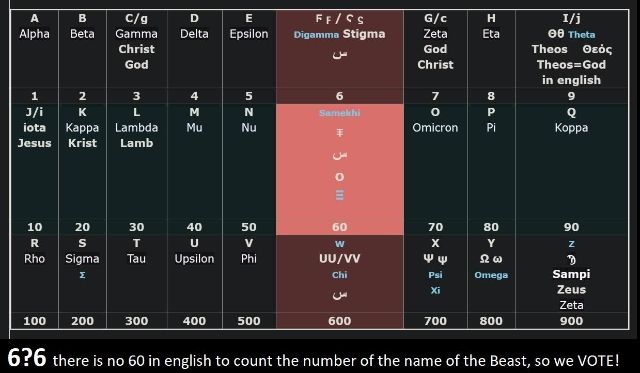
#W?F #WΞF #W𐤎F World Economic Forum? based upon the #Correct English Gematria
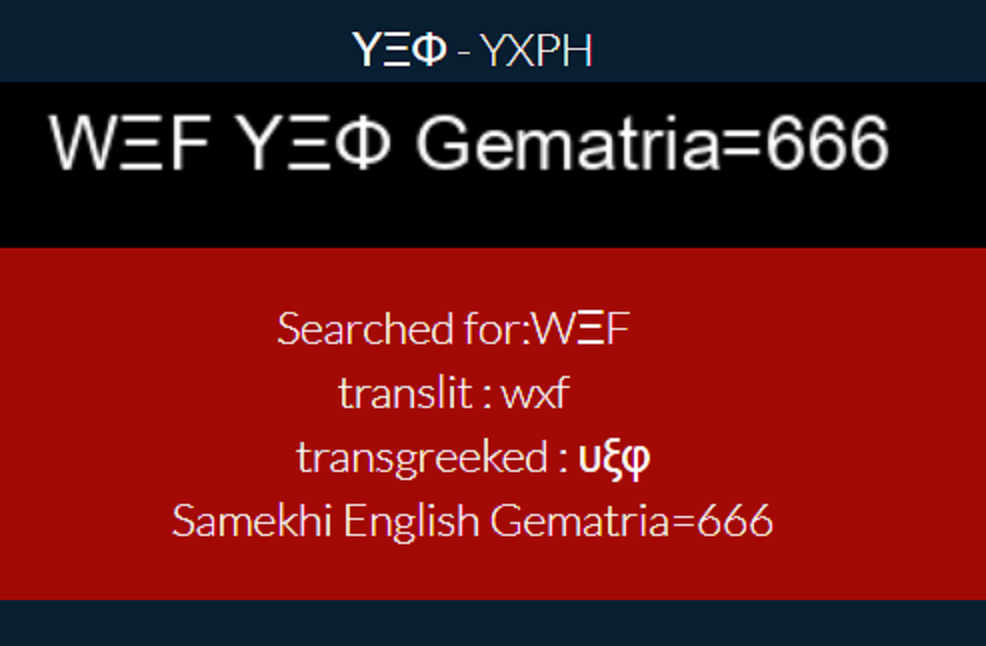
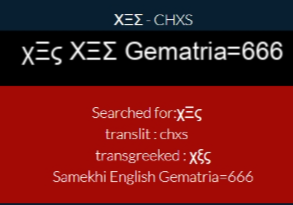
Lets have a look at the Egyptian 𓌉 6 stigma to brand or mark, coil of rope 𓌉 noose, hook, the 𓌉 sure looks like Needle to prick ya with?
𓌉 |
𓌉 |
f |
sw |
6 |
EGYPTIAN HIEROGLYPH T003 | U+78601 | 𐤅 The hieroglyph depicting a coil of rope and meaning the number “hundred” 𓍢 named šet became 𐤅 named wāw meaning “hook” to represent the W sound. In Hebrew it’s ו named “vav.” In Greek, Y; in Latin, F, U, V, Y, or W |
616  𓏴𓂝𓌉
𓏴𓂝𓌉
𓂝 |
𐤉 |
i |
pl |
10 |
EGYPTIAN HIEROGLYPH D036 | U+77981 | 𐤉 The hieroglyph for “arm” 𓂝 became 𐤉 named jōd meaning “arm” or “hand” to represent the Y sound, as in “you.” In Hebrew it’s י named “yod.” In Greek or Latin, it’s Ι or J. |
I |
The hieroglyph for “arm” 𓂝 became 𐤉 named jōd meaning “arm” or “hand” to represent the Y sound, as in “you.”
In Hebrew it’s י named “yod.” In Greek or Latin, it’s Ι iota or J.
616 χΙς 𓏴𓂝𓌉reverse it 𓌉goes in 𓂝 gets ya 𓏴
𓌉𓂝 𓏴 is still 616
Etymology Stigma From Latin stigma, from Ancient Greek στίγμα (stígma, “to brand”), from στίζω (stízō, “I mark”).
Revelation 13:16-17
And he causeth all, both small and great, rich and poor, free and bond, to receive a mark in their right hand, or in their foreheads:
And that no man might buy or sell, save he that had the mark, or the name of the beast, or the number of his name.
Remain 𓌉𓌉 PureBlood 𐌎
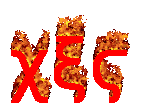
Correct English Gematria |
||||||||
| Greek Letter | Greek Name | English Letter | Numeric Value | Greek Letter | Greek Name | English Letter | Numeric Value | |
| Α, α | alpha | A | 1 | Ξ,ξ | xi, samekhi | ??????? | 60 | |
| B, β | beta | B | 2 | O, ο | omikron | O | 70 | |
| Γ, γ | gamma | C, G | 7 | P, π | pi | P | 80 | |
| Δ, δ | delta | D | 4 | ϟ Ϟ | Coph | Q | 90 | |
| Ε, ε | epsilon | E | 5 | Ρ ρ | rho | R | 100 | |
| F | Digamma | F | 6 | Σ, σ, ς* | sigma | S | 200 | |
| Z, ζ | zeta | G, C | 3 | T, τ | tau | T | 300 | |
| H, η | eta | H | 8 | Υ, υ | upsilon | U | 400 | |
| Θ, θ, 𓄤 | theta | I, J | 9 | Φ, φ | phi | V | 500 | |
| I, ι | iota | J, I | 10 | Χ, χ | chi | W | 600 | |
| K, κ | kappa | K | 20 | Ψ, ψ | psi | X | 700 | |
| Λ, λ | lamda | L | 30 | Ω, ω | omega | Y | 800 | |
| M, μ | mu | M | 40 | Ϡ | sampsi | Z | 900 = sampsi | |
| N, ν | nu | N | 50 | Trinity Ψ, ψ psi became image of Ξ,ξ xi to become english letter X, replacing Χ, χ chi with W, so 666 = W?F WΞF WΣF WEF Gothic letter 𐍅 uuinne/vinja, which is transliterated as W Alpha to Omega, Yahweh YHWH |
||||
The Ο in Οmicron is not the same Ο as in Οmega.
Will The Circle Be Unbroken?
Check out the most updated dbversion of the Gematria of the Egyptian Hieroglyph's

Please check out Book of Signs, used as a reference for the hieroglyphs & wiki.
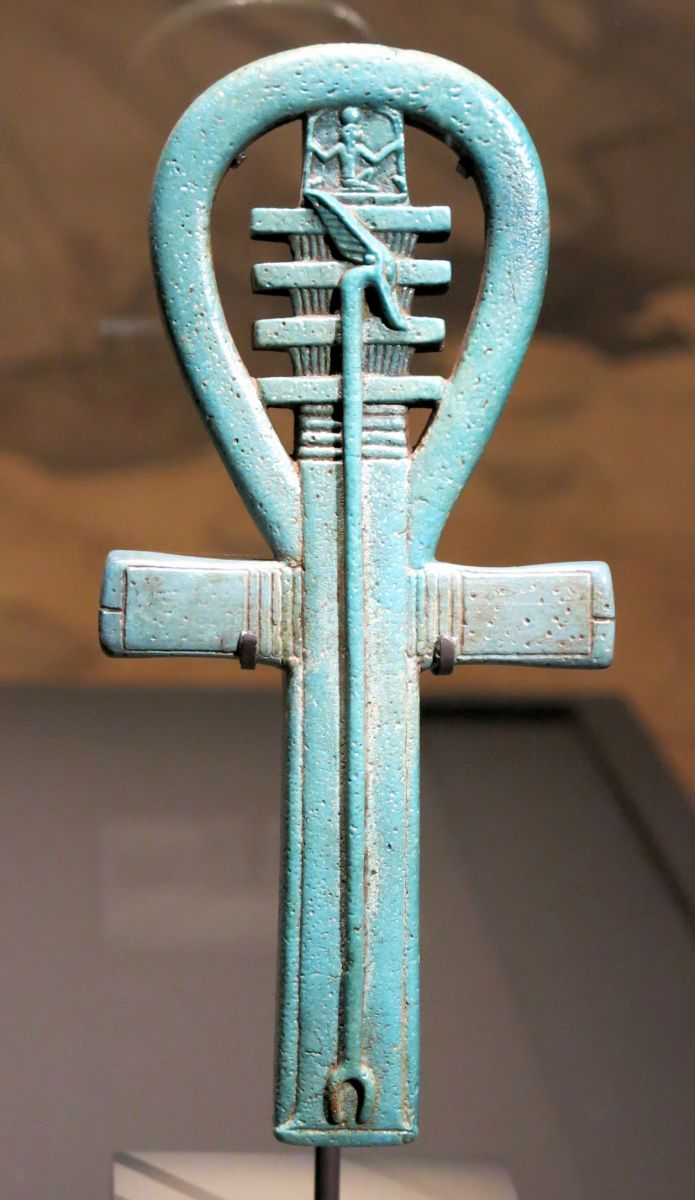

.jpg)
